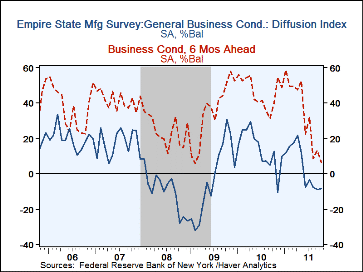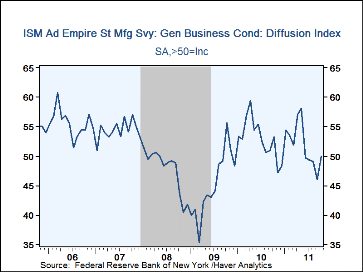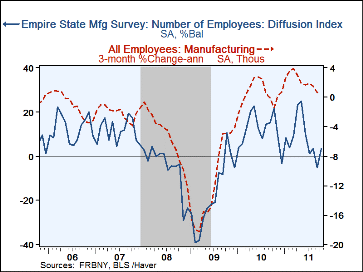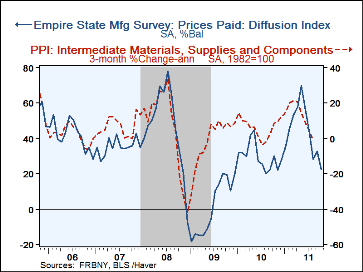 Global| Oct 17 2011
Global| Oct 17 2011Empire State Factory Index Remains Under Pressure
by:Tom Moeller
|in:Economy in Brief
Summary
The Federal Reserve Bank of New York reported that its Empire State Factory Index of General Business Conditions ticked up to -8.48 in October. Nevertheless it remained roughly where it's been since June. The number was weaker than [...]
The Federal Reserve Bank of New York reported that its Empire State Factory Index of General Business Conditions ticked up to -8.48 in October. Nevertheless it remained roughly where it's been since June. The number was weaker than Consensus expectations for -4.0. Based on these figures, Haver Analytics calculates an index that is compatible to the ISM series. The adjusted figure rose to 49.9 and recovered its September drop. The Empire State figures are diffusion indexes which are calculated by subtracting the percent of respondents reporting poorer business conditions from those reporting improvement. Thus, they have a good correlation with growth in the series covered. Since inception in 2001, the business conditions index has a 65% correlation with the quarterly change in real GDP.
The component series were mostly improved last month. New orders and shipments returned to positive territory. The employment series also was positive as it recovered its September deterioration. During the last ten years there has been an 81% correlation between the index and the m/m change in the BLS measure of factory sector employment. Moving the other way, the prices paid index fell to its lowest since September of last year. During the last ten years there has been a 63% correlation between the index and the 3-month change in the intermediate goods PPI.
The Empire State index of expected business conditions in six months fell to its lowest level since February 2009. Performance amongst the subseries was mixed. Capital spending and technology spending both fell to their lowest since 2009.
The Empire State data is available in Haver's SURVEYS database. The Empire State Business Conditions Index reflects answers to independent survey questions; it is not a weighted combination of the components. The ISM-adjusted headline index is calculated by Haver Analytics using the underlying response data from each survey to construct an overall index using the ISM methodology. This provides for better comparability across regions with the national ISM index. The series date back only to 2001. The Consensus expectation figure is in Haver's AS1REPNA database.
| Empire State Manufacturing Survey | Oct | Sep | Aug | Oct'10 | 2010 | 2009 | 2008 |
|---|---|---|---|---|---|---|---|
| General Business Conditions (ISM Adjusted) | 49.9 | 46.1 | 49.1 | 53.2 | 52.9 | 45.2 | 47.7 |
| General Business Conditions (diffusion index, %) | -8.48 | -8.82 | -7.72 | 12.74 | 13.80 | -2.81 | -9.96 |
| New Orders | 0.16 | -8.00 | -7.82 | 10.02 | 9.93 | -2.51 | -6.23 |
| Shipments | 5.33 | -12.88 | 3.01 | 18.38 | 11.66 | 2.80 | 0.36 |
| Unfilled Orders | -4.49 | -7.61 | -15.22 | -1.67 | -6.58 | -13.36 | -8.72 |
| Delivery Time | -1.12 | -1.09 | 0.00 | -6.67 | -2.87 | -8.18 | -3.63 |
| Inventories | -8.99 | -11.96 | -7.61 | -11.67 | -1.48 | -22.89 | -7.87 |
| Employment | 3.37 | -5.43 | 3.26 | 11.67 | 14.29 | -17.28 | -5.36 |
| Prices Paid | 22.47 | 32.61 | 28.26 | 30.00 | 29.63 | 1.33 | 46.99 |
Tom Moeller
AuthorMore in Author Profile »Prior to joining Haver Analytics in 2000, Mr. Moeller worked as the Economist at Chancellor Capital Management from 1985 to 1999. There, he developed comprehensive economic forecasts and interpreted economic data for equity and fixed income portfolio managers. Also at Chancellor, Mr. Moeller worked as an equity analyst and was responsible for researching and rating companies in the economically sensitive automobile and housing industries for investment in Chancellor’s equity portfolio. Prior to joining Chancellor, Mr. Moeller was an Economist at Citibank from 1979 to 1984. He also analyzed pricing behavior in the metals industry for the Council on Wage and Price Stability in Washington, D.C. In 1999, Mr. Moeller received the award for most accurate forecast from the Forecasters' Club of New York. From 1990 to 1992 he was President of the New York Association for Business Economists. Mr. Moeller earned an M.B.A. in Finance from Fordham University, where he graduated in 1987. He holds a Bachelor of Arts in Economics from George Washington University.










